|
|
|
Sort Order |
|
|
|
Items / Page
|
|
|
|
|
|
|
| Srl | Item |
| 1 |
ID:
154355
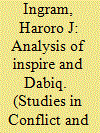

|
|
|
|
|
| Summary/Abstract |
This study analyzes how Inspire and Dabiq seek to appeal to and radicalize English-speaking Muslims. It examines how each magazine strategically designs ingroup, Other, crisis, and solution constructs and interplays these via value-, dichotomy-, and crisis-reinforcing narratives. This analysis also explores how narrative, imagery, and counternarrative messaging are used to shape readers' perceptions and polarize their support. While both magazines are dominated by narratives designed to empower readers toward action, Inspire relies heavily on identity-choice appeals while Dabiq tends to balance identity- and rational-choice messaging. This study concludes by identifying key lessons for counterterrorism strategic communications campaign and message design.
|
|
|
|
|
|
|
|
|
|
|
|
|
|
|
|
| 2 |
ID:
139451
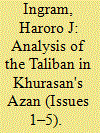

|
|
|
|
|
| Summary/Abstract |
This article analyzes issues 1–5 of the Taliban in Khurasan's Azan magazine. It applies an interpretive framework for analyzing radical narratives, based on a multidisciplinary conceptualization of the radicalization process, to explore how Azan attempts to appeal to its audiences by leveraging ingroup, Other, crisis and solution constructs via value-, crisis-, and dichotomy-reinforcing narratives. Two key findings emerge. First, Azan prioritizes content that empowers its readership toward action with narratives that link ingroup and solution constructs. Second, Azan uses a variety of narrative approaches in order to appeal to a potentially diverse readership at different stages of radicalization.
|
|
|
|
|
|
|
|
|
|
|
|
|
|
|
|
| 3 |
ID:
142230
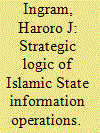

|
|
|
|
|
| Summary/Abstract |
Drawing on English and Arabic Islamic State (IS) communiqués produced by its central media units, wilayat information offices and broader supporter base, this study examines the strategic logic of IS information operations (IO). It argues that the overarching purpose of IS's IO campaign is to shape the perceptions and polarise the support of audiences via messages that interweave appeals to pragmatic and perceptual factors. Pragmatic factors—such as security, stability and livelihood—are leveraged in IS messaging by promoting the efficacy of its politico-military campaign and denigrating its enemies’ efforts via rational-choice (logic of consequence) appeals. Perceptual factors—which are tied to the interplay of in-group, Other, crisis and solution constructs—are leveraged via identity-choice (logic of appropriateness) appeals that frame IS as the champion of Sunni Muslims (the in-group identity), its enemies as Others complicit in Sunni perceptions of crisis, and IS as the only hope for solving this malaise. With this approach, IS seeks to resonate its message across a diverse ‘glocal’ constituency and supercharge supporters towards action. IS simultaneously targets its enemies with messaging that manipulates the inherent dualities underlying perceptual and pragmatic factors, vigorously counters criticisms and ‘baits’ opponents into ill-conceived IO responses.
|
|
|
|
|
|
|
|
|
|
|
|
|
|
|
|
| 4 |
ID:
171663
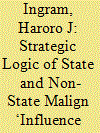

|
|
|
|
|
| Summary/Abstract |
Malign ‘influence activities’ conducted by state and non-state adversaries are one of the most pressing security challenges facing democracies globally. Haroro J Ingram offers a framework through which to understand the overarching strategic logic of a diverse spectrum of propaganda and disinformation threats targeting democratic populations. He argues that these activities seek to erode social trust, trust in authorities/expertise and trust in democracy, driving psycho-social and strategic effects that may contribute to the weakening of democratic institutions and processes. He concludes by identifying three strategic policy pillars that could be used to develop a more assertive posture for the protection and projection of democracy.
|
|
|
|
|
|
|
|
|
|
|
|
|
|
|
|
| 5 |
ID:
135969
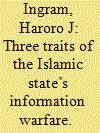

|
|
|
|
|
| Summary/Abstract |
If the West is to defeat the self-proclaimed Islamic State, it must understand the reasons for the success of the group’s information warfare. The success of the Islamic State throughout the ‘fertile crescent’ is a striking example of a modern insurgency, and information operations have played a central role in the group's strategy. Drawing on primary sources, Haroro J Ingram analyses three traits of the Islamic State's information warfare: the use of a multidimensional, multi-platform approach that simultaneously targets ‘friends and foes’ to enhance the reach, relevance and resonance of its messaging; the synchronisation of narrative and action to maximise operational and strategic ‘effects’ in the field; and the centrality of the Islamic State ‘brand’ to its entire campaign.
|
|
|
|
|
|
|
|
|
|
|
|
|
|
|
|
|
|
|
|
|